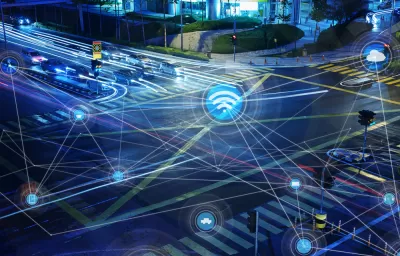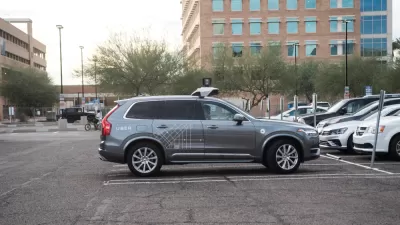A call for planners, policy makers, and the car industry to assertively lead the policy development in anticipation of the coming wave of autonomous vehicle technology.

As market innovation continues to accelerate the development of autonomous vehicles (AVs) and wider acceptance of shared mobility systems like Uber and Lyft (a less-than-subtle step toward automation), critiques of the technology presume that there will be no rules, regulations, or policies that respond to autonomous vehicle technology. We have already outlined many of these policy critiques, such as the belief that AVs will worsen urban sprawl, in past posts from our series on the Autonomous Future. Certainly, any technology that reduces the financial and time cost of transportation has the potential to increase urban sprawl, but this does not mean that we will be unable to anticipate and address these challenges.
The lack of certainty about the implications of AVs and shared mobility does not mean we "know virtually nothing" about how AVs will impact society. The range of potential impacts of AVs on communities is becoming clearer, and even with uncertainty, we can and should develop plans and policies based the best information available. These policies need to be focused on the vehicular level, but they also need to focus on the built environment and the socio-economic impacts of AVs—areas that are currently under-discussed in the policy spectrum. The federal government has started to issue guidance at the vehicular level, but offers far less guidance around topics such as land use and transportation planning, infrastructure, economic development and jobs, ethics, and technology reliability.
As noted in a previous op-ed on the current "business as usual approach" to AVs, policy-makers are not responding as quickly as needed. Several recent reports illustrate potential downsides of AVs and provide a rationale for robust policy responses. In this context, we suggest a policy agenda in the areas of: 1) transportation and land use; 2) infrastructure; 3) ethics, liability, and the legal aspects of driverless vehicles; and 4) economics and jobs. In each of these areas, we shall discuss primary concerns and offer potential policy solutions. We do not claim that our suggestions will definitively solve all of problems posed by autonomous vehicles (it is likely too early to do that). Instead, we suggest potential policy responses to these challenges, and that now is the time for government officials, the AV industry, and the public to begin discussing them.
It is also important to note that we continue to assume an autonomous future largely based on the concept of shared-use vehicles—that most autonomous vehicles will be shared and operate in large fleets. This is a foreseeable evolution of the utility provided transportation network companies (TNCs) like Lyft and Uber. The concept of shared AVs is also consistent with the expert opinion synthesized by Lipson and Kurman in their book Driverless, reflecting the general market direction of automakers, as seen at the 2017 Consumer Electronics Show. We refer to these highly autonomous fleets as driverless electric fleets (DEFs), and assume that though the costs of AVs might eventually go down (due to Moore's Law and other factors), the economics of paying for rides will remain a cheaper option than owning such a vehicle in the immediate future. The social norm of reduced vehicle ownership will likely continue to influence the market for DEFs, as opposed to individually owned AVs.
Land Use, Parking, and Placemaking
Some future AV scenarios describe an increased use of the car and miles driven, increased parking demand, and a more congested urban environment. While that could be the case in the absence of policy, we believe that proactive public policy can curb increases in vehicle miles traveled (VMT), particularly as a result of DEFs. Furthermore, there has been substantial dialogue on the effect a fully autonomous future will have on auto-serving land uses and parking. Many believe that on-street parking will no longer be as necessary, as autonomous vehicles can deliver urban patrons directly to their destination. Such direct service, however, conflicts with traditional urban design principles, because the experience walking of to and from a destination, and the resulting random interactions, sights, and experiences along the way, are part of what makes cities livable and desirable.
The policy suggestions below address how AVs might impact urban spaces and land uses.
Land Use
- Plan and re-zone industrial parcels outside of downtown for future transition to autonomous service areas that provide service for DEFs. Such parcels should not be greenfield sites, but focus on transitioning existing production, warehousing, and auto-serving uses to support new industry and jobs that arise as a part of the autonomous future. Rezoning should be use specific, so it does not have the effect of weakening the attractiveness of tech and mixed-use office investment in downtowns or counteract smart-growth and car-free downtown initiatives.
- Up-zone or provide overlay zoning for existing service stations and repair facilities within the urban core, allowing such facilities to transition to alternative uses as autonomous service facilities become focused on the outskirts of cities in areas targeted for less density. If such uses stay in the urban core, provide for mixed-use capacity above these facilities.
Placemaking
- Consider appropriate locations for drop offs, to ensure lively downtown environments. Such locations should not only focus on the convenience afforded by AVs (or TNCs like Lyft and Uber), but also on creating interaction and vitality through exchange with urban features at the pedestrian scale and designing spaces for human interaction.
- In conjunction with the drop-off zone concept, consider limiting automobile access to downtowns, especially in the most congested areas. Such restrictions can be accomplished through street closures, traffic calming, and time-of-day pricing or access.
- Plan for the gradual recapture and transition of road right-of-way to increase bicycle and pedestrian level of service (LOS)—an argument that we have already advocated for to fight against increased driving.
Parking
- Stop building new parking as a part of existing land use policy and make plans to repurpose existing parking and parking structures. If parking structures are in the pipeline, design and build them so that they are convertible to other uses in the future.
- Ensure general plan and local planning documents provide for on-street parking conversion to parklets, pocket parks, and other pedestrian and bike friendly amenities.
- Continue to lower or eliminate parking minimums.
- Continue to support EV chargers and other infrastructure required for EV fleets, autonomous or human-piloted.
- Consider transitioning to parking maximums and car-free housing units and remove parking requirements for accessory dwelling units.
- Establish a revenue replacement plan for the loss of parking revenue.
- Plan for and implement regional roadway pricing to incentivize development within the urban core, limit increases in driving and greenhouse gas emissions and pay for the infrastructure burdens of driving. These might include pricing by: cordon (i.e., geographically-based) pricing or a congestion zone, vehicle miles traveled (VMT), person-miles traveled (PMT), vehicle occupancy, fuel type/efficiency, road type, and speed of trip (e.g., traffic priority payments). Two key challenges will be making these policies transparent to end users while meeting land use and mobility objectives and ensuring that these policies do not create insurmountable barriers to access and affordability. Policymakers should explore how citizens (and corporations) interpret and respond to potential policies as specific alternatives are developed.
- Explore how the same algorithmic neural networks and machine learning processes might inform new ways of thinking about activity-based transportation models in land use and transportation planning processes.
Infrastructure
There has been only limited discussion on how infrastructure and roadway design should accommodate AVs. Some argue that infrastructure must be designed for non-automated and automated driving. Yet Waymo (Google's AV company spinoff) has claimed that their trips are generating 0.2 instances of drivers re-engaging control of the vehicle for every 1,000 miles of automated travel. The geometry and capacity of existing roads is designed for human drivers, so augmentations will likely be necessary—including how roads support multi-modal travel for trains, bikes, and pedestrians.
In the simplest sense, roadway geometry involves horizontal alignment (e.g., curve dynamics and sight distance) and vertical alignment (e.g., sight distances at crests). Roadway geometry also involves distance from physical elements on the edge of the roadway cross section. It is likely that in a fully autonomous future, neighborhood streets could be narrower, intersections may not need signalization, and speed controls can become more context sensitive (e.g., responding to inclement weather or other conditions). Road diets may become easier, given the increased LOS on existing roadways, and context sensitive speed areas will be become more prevalent. In a fully autonomous environment the concept of reversible lanes could be extended to dynamically allocate major portions of infrastructure.
Places like Oslo, Dublin, Paris, and elsewhere around the EU are experimenting with car-free downtown environments. A similar vision has been established for Manhattan. While these cities still provide space for both human-driven cars and AVs, considering the interface between multiple modes and infrastructure, we propose the following policy considerations:
- Consider rethinking and halting smart road and intelligent transportation systems (ITS) roadway infrastructure as DEFs and AVs are rolled out so that roadway infrastructure is developed in the most appropriate and cost-effect manner. Literature already indicates that fully autonomous vehicles will eventually be capable of handling all urban and rural driving conditions without surrounding roadway infrastructure, as we mentioned in past posts. We suggest that pausing all but the most basic infrastructure investments would be wise, particularly roadway expansions and vehicle-to-infrastructure (V2I) and vehicle-to-vehicle (V2V) investments. An important role that V2X (vehicle connecting to both infrastructure and vehicles) technology might play in the future would be to provide additional system redundancy for bicycle and pedestrian safety. We believe that both the infrastructure and the vehicle technology will likely co-evolve in a way to best optimize safety in a connected system.
- In areas of VMT growth, existing pavement standards will need to be re-evaluated in the context of higher usage.
- Establish a policy to invest in and renew existing "dumb" roadway infrastructure without expanding it to support the visual cues that driverless machine learning processes employ, such as signage and lane markings. In addition, develop clear policy, standards, and funding strategies for maintaining up-to-date digital and physical street markings, which may rely on the aforementioned pricing strategies delivered to individuals or corporations.
- Integrate multimodal level of service (LOS) analysis in infrastructure design and planning for AVs.
- Adopt vision-zero plans and support NACTO guidelines that provide high LOS to non-automotive users.
- Continue to explore and implement road diets.
- Consider a moratorium on roadway capacity projects, or, for a more radical idea, tie extra federal funding to capacity.
Ethical Implications
A fair summary of comprehensive reviews of the ethical issues emerging from AVs can be found on the agenda of the 2016 Transportation Research Board's sponsored symposium on autonomous vehicles and in a recent Planetizen post. Ethical issues include things like how computer algorithms can make value judgments (e.g., the "trolley problem") and how licensing and insuring can and should be enforced when the human behind the wheel may not be driving the vehicle. Other issues include providing equitable access to DEFs (something that has been an issue for companies like Lyft and Uber), maintaining equitable access to public spaces and infrastructure, and enforcing adequate privacy standards.
Our policy suggestions include the following:
- Establish a specific federal agency or high-level unit within an existing agency to both facilitate and guide development and adoption of fully autonomous driverless—particularly focusing on the safety standards, liability, and ethical dilemmas that have been loosely outlined by the federal government but require further development. In January 2016, former U.S. Department of Transportation Secretary Anthony Foxx established a committee focused on autonomy [pdf], but such actions should be taken further as a part of the new administration, dedicating staff to focus on a policy agenda that includes the items below at minimum.
- Work with state and federal officials to ensure that adequate safety judgments are embedded in machine learning algorithms that prioritize non-motorized user safety alongside driver safety.
- Work with state and federal working groups on licensing and insurance issues.
- Analyze equity, access, and multi-modal connectivity issues using new forms of data, such as Uber's new open-data platform, Movement. Though Movement provides some data, it remains limited in its ability to inform the type of complex origin-to-destination and capacity analysis that cities need to fully understand shared and autonomous mobility platforms. New sources of data, and more robust and granular data, could help better integrate individual or shared AVs into existing transit systems.
- Develop policy for public funding to support access and service standards.
Economics
Finally, job losses and roadway pricing policies will remain primary concerns relative to the economic implications of AV technology. First, economic policy must acknowledge that artificial intelligence will likely replace many jobs, not just drivers. Second, with regard to jobs involving driving, we acknowledge that many existing jobs will be replaced by autonomous technology. Some individuals, particularly professional drivers, may need to retool and pursue new education to smooth a transition to another field. These types of changes are nothing new—with almost every technological transition in history, there have been changes to the way we work. The examples range from stagecoach drivers to switch board operators. Yes, there may be a loss of certain types of jobs, but there will be increases in other areas, and there are already policies in place to help displaced workers improve their skillsets and enter other industries.
More significant in scale than transitions between job sectors and types might be the potential economic impacts on city budgets. As large portions of the population adopt AVs, there will likely be a loss in certain types of city revenue. Policies and strategies to mitigate these losses will be necessary, and it's possible to view this shift as a highly negative impact. The coming shift also presents an opportunity to introduce innovative methods of pricing resources and framing destinations based on accessibility. If fewer parking spaces are needed, then perhaps more sophisticated ways of documenting and charging for annual VMT should be put in place. Perhaps wider use of a fuel tax (whether it be gas or electric) should be discussed as a way of reducing economic losses while promoting multi-modal, bicycle, and pedestrian transportation goals.
Specific policy agenda items might involve the following:
- Explore how AV and shared mobility policy relate to social equity, particularly with regard to pricing and infrastructure burdens. In particular, acceptable policies should create disincentive to increase travel behavior, but not create regressive effects that inhibit mobility for low-income residents or certain geographically concentrated areas.
- Develop transportation demand management policies that integrate and incentivize time and monetary synergies between networked vehicles and DEFs.
- Develop policy to reduce job loss impacts and retrain and reskill workers for new job sectors that arise as a part of the new AV economy; explore who bears the cost of these impacts (i.e., whether they are public or private).
- Establish algorithmic service standards that ensure AV access, particularly for shared AVs, irrespective of individual rider characteristics or location.
'Lead, Follow, or Get Out of the Way'
In a famous 1992 ad campaign, Chrysler CEO Lee Iacocca said, "…in this business, you lead, follow, or get out of the way." Urban planners, policy makers and those in industry need to double down on that ethos and assertively lead in policy development for autonomous technology. Rather than allow the evolution of AV technology to drive policy or delay action until we know more, cities can choose the kind of places they want to create and leverage policy to make AVs conform to that vision. Our policy suggestions might not hold the final solution for roadway design and the built environment of communities, but they will help communities evolve as technology advances. These policies will allow nimble responses to what is now a field filled with uncertainty and unknowns.
These policies will also require a broad spectrum of transportation, engineering, and land use professionals to engage on this topic. We believe that organizations like the American Planning Association (APA), Institute of Transportation Engineers (ITE), National Association of City Transportation Officials (NACTO), the National Academies, and the Transportation Research Board (TRB), along with the federal and state departments of transportation, all have a role in this dialogue. We challenge researchers, policymakers, planners, and industry leaders to start developing these policies now, so that cities can proactively guide emerging autonomous vehicle innovations. We challenge our country to lead innovation in an autonomous future.
William (Billy) Riggs, PhD is an Assistant Professor of City & Regional Planning and a leader in the area of transportation planning and technology, having worked as a practicing planner and published widely in the area. He has over 50 publications and has had his work featured nationally by Dr. Richard Florida in The Atlantic. He is also the principal author of Planetizen's Planning Web Technology Benchmarking Project. He can be found on Twitter @williamwriggs.
Michael R. Boswell, PhD is a Professor of City & Regional Planning at Cal Poly, San Luis Obispo and is one of the preeminent expert on strategies to reduce greenhouse emissions and and local climate action planning. He is lead author of the book Local Climate Action Planning and most recently advised UN-Habitat on climate planning as a part of COP 21. His Twitter handle is @mboswell.
Stephen Zoepf, PhD is the Executive Director of the Center for Automotive Research at Stanford. He holds a PhD., M.Sc. and B.Sc. from MIT and has 15 years of experience in transportation and mobility. Dr. Zoepf led U.S. Department of Transportation efforts to integrate confidential data into national vehicle energy policy modeling, and previously worked as an engineer and product manager at BMW and Ford. He was an ENI Energy Initiative Fellow, a Martin Energy Fellow, and a recipient of the Barry McNutt award from the Transportation Research Board and the Infinite Mile award from MIT. His research has been covered in numerous popular press articles, initiated a Congressional probe, and has been lampooned in The Onion.

Planetizen Federal Action Tracker
A weekly monitor of how Trump’s orders and actions are impacting planners and planning in America.

Restaurant Patios Were a Pandemic Win — Why Were They so Hard to Keep?
Social distancing requirements and changes in travel patterns prompted cities to pilot new uses for street and sidewalk space. Then it got complicated.

Map: Where Senate Republicans Want to Sell Your Public Lands
For public land advocates, the Senate Republicans’ proposal to sell millions of acres of public land in the West is “the biggest fight of their careers.”

Maui's Vacation Rental Debate Turns Ugly
Verbal attacks, misinformation campaigns and fistfights plague a high-stakes debate to convert thousands of vacation rentals into long-term housing.

San Francisco Suspends Traffic Calming Amidst Record Deaths
Citing “a challenging fiscal landscape,” the city will cease the program on the heels of 42 traffic deaths, including 24 pedestrians.

California Homeless Arrests, Citations Spike After Ruling
An investigation reveals that anti-homeless actions increased up to 500% after Grants Pass v. Johnson — even in cities claiming no policy change.
Urban Design for Planners 1: Software Tools
This six-course series explores essential urban design concepts using open source software and equips planners with the tools they need to participate fully in the urban design process.
Planning for Universal Design
Learn the tools for implementing Universal Design in planning regulations.
Heyer Gruel & Associates PA
JM Goldson LLC
Custer County Colorado
City of Camden Redevelopment Agency
City of Astoria
Transportation Research & Education Center (TREC) at Portland State University
Camden Redevelopment Agency
City of Claremont
Municipality of Princeton (NJ)





























